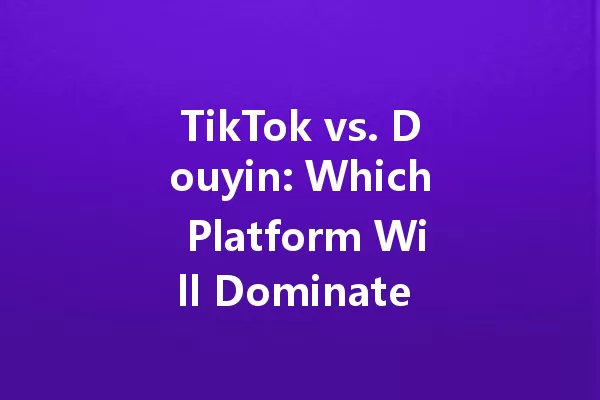
With the rapid globalization of social media, platforms like TikTok and Douyin have emerged as significant players in the digital landscape. Although they share a common foundation, their evolution and market dynamics reveal striking differences. This article delves into these two platforms, assessing their features, content styles, and audience engagement strategies.
The Origins and Growth of TikTok and Douyin
TikTok was launched internationally in September 2016, quickly gaining traction across various demographics. Douyin, its Chinese counterpart, was launched shortly before in September 2016 and caters exclusively to the Chinese market. Both platforms share the same parent company, ByteDance, which has cleverly adapted their functionalities to meet the needs of their respective audiences.
The rapid rise of these platforms reflects the changing landscape of entertainment consumption. Users, particularly younger generations aged between 5-24, are drawn to short, engaging video content that is both entertaining and informative. This age demographic has shaped the way content is created and consumed on both platforms, fueling their growth.
User Interface and Features
The user interface of TikTok and Douyin is designed for ease of use, promoting seamless content creation and consumption. However, notable differences exist in their features:
Audience Engagement Strategies
The engagement strategies of TikTok and Douyin exemplify their approaches to content consumption. TikTok encourages user-generated content through challenges and trending hashtags, creating a vibrant community. Users participate in various challenges, showcasing their creativity while connecting with a global audience.
In contrast, Douyin emphasizes influencer marketing heavily, with brands often collaborating with popular creators to promote products. This strategy not only drives brand engagement but also influences purchasing decisions effectively. The platform’s ability to integrate social media with e-commerce is a game-changer, particularly in a consumer-driven market like China.
Comparative Growth Metrics
In recent years, the growth trajectory of both platforms illustrates their increasing popularity. The following table highlights key metrics such as user count, average time spent, and engagement rates, providing clarity on their performance.
| Platform | User Count (2025) | Average Time Spent (minutes) | Engagement Rate (%) | Key Features |
|---|---|---|---|---|
| TikTok | 1.2 Billion | 52 | 15.5 | Trends, Challenges |
| Douyin | 600 Million | 63 | 20.2 | E-commerce, Live Streaming |
Cultural Influences and Content Styles
Cultural influences are paramount in shaping the content styles on TikTok and Douyin. In the West, TikTok thrives on humorous, trendy, and often spontaneous content. Users experiment with creativity, often leaning towards viral trends.
On the other hand, Douyin’s content reflects a deep-rooted connection to Chinese culture, incorporating elements of traditional art, music, and popular trends. Users engage with tutorials, storytelling, and more polished content, balancing entertainment with educational value.
This divergence in content styles not only depicts the creative freedom offered by both platforms but also illustrates their adaptability to cultural nuances, reinforcing their appeal among differing audiences.
When diving into the world of short-form video platforms, it’s fascinating to see how TikTok and Douyin have carved out their unique spaces in the digital landscape. While they might look similar at first glance, their core differences become apparent when you start using them. TikTok has become a global phenomenon, with its algorithm designed to surface trending content that resonates across borders. It’s all about viral challenges, dance trends, and user-generated content that can spread like wildfire. On the other hand, Douyin operates as a more localized experience, deeply integrated with China’s digital ecosystem. It’s not just about entertainment – it’s a full-fledged social commerce platform where users can shop, watch live streams, and engage with content that’s specifically tailored to Chinese cultural preferences.
The way these platforms engage with their users is particularly interesting. TikTok’s success lies in its ability to create a sense of global community, where trends can start anywhere and spread everywhere. The platform’s algorithm is designed to be borderless, often surfacing content from creators across different countries and cultures. Meanwhile, Douyin has mastered the art of hyper-localization. Its content is deeply rooted in Chinese culture, from traditional performances to modern lifestyle content, all while seamlessly integrating e-commerce features. This isn’t just about watching videos – it’s about creating a complete digital ecosystem where entertainment, shopping, and social interaction coexist. The platform’s success in China demonstrates how powerful this integrated approach can be, especially when it comes to engaging the younger demographic of 5-24-year-olds who are looking for more than just entertainment in their social media experience.
Frequently Asked Questions (FAQ)
What are the main differences between TikTok and Douyin?
TikTok is geared towards a global audience and focuses on trends and user-generated content, while Douyin caters exclusively to the Chinese market and offers additional features like e-commerce integration and localized content strategies.
Can I use TikTok and Douyin interchangeably?
No, TikTok and Douyin are separate apps designed for different markets and audiences. While they share similar functionalities, the content, features, and algorithms are distinctly tailored to their respective user bases.
How important are cultural influences in shaping content on these platforms?
Cultural influences play a significant role in the content styles on TikTok and Douyin. TikTok often features humorous and trendy content appealing to a Western audience, while Douyin integrates elements of Chinese culture, including traditional art and local trends.
What age group uses TikTok and Douyin the most?
The primary user demographic for both TikTok and Douyin falls within the age group of 5-24, making them popular among young people who are drawn to short, engaging video content.
How do brands leverage TikTok and Douyin for marketing?
Brands utilize TikTok for user-generated content and trending challenges to engage with a broader audience, while on Douyin, they often collaborate with influencers and tap into e-commerce capabilities for direct sales and targeted marketing campaigns.
内容结尾插入,支持HTML代码,如果不需要请删除